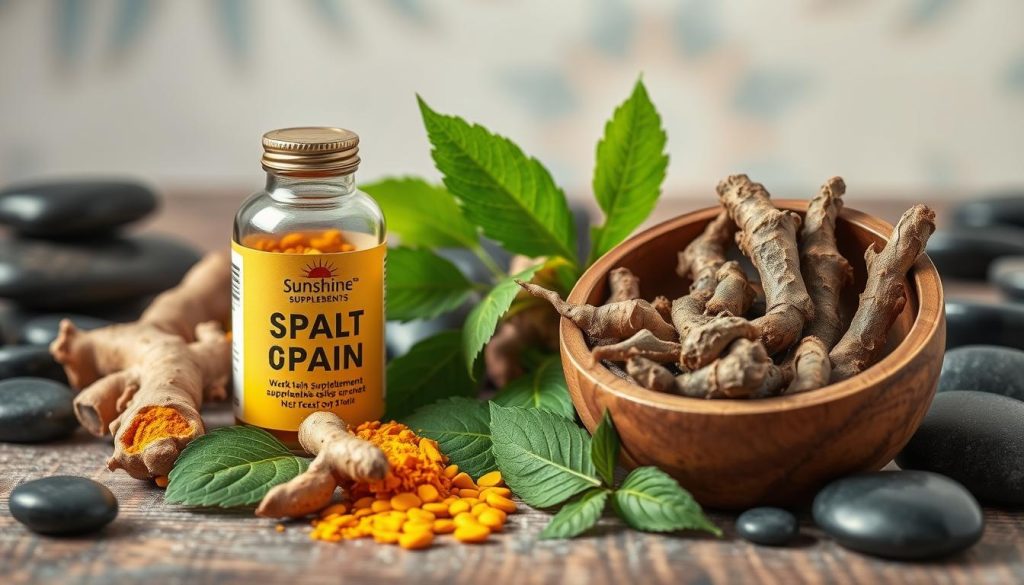Did you know 91.2 million adults in the United States have arthritis? This condition causes joint pain and swelling. The good news is natural remedies can help ease this discomfort.
Herbs with anti-inflammatory properties and heat and cold therapies are just a few options. They can be used at home to manage joint pain. Whether it’s osteoarthritis, rheumatoid arthritis, or other conditions, natural remedies offer hope for relief.
Key Takeaways
- Certain herbs, such as aloe vera, eucalyptus, and ginger, have been shown to possess anti-inflammatory properties that may provide relief for joint pain.
- Complementary therapies like acupuncture, weight management, and a healthy diet can also play a role in managing joint discomfort.
- It’s important to consult with a healthcare professional before incorporating natural remedies, as some may interact with existing medications.
- A combination of natural and conventional treatments can often provide the most effective approach to managing joint pain and improving overall joint health.
- Maintaining an active lifestyle through low-impact exercises and targeted stretching can help strengthen the joints and improve mobility.
Understanding Joint Pain and Its Common Causes

Joint pain is a common problem in the U.S., with arthritis being a major cause. There are many types of arthritis, each with its own symptoms and risk factors.
Types of Arthritis Affecting Joints
- Osteoarthritis (OA): This is the most common type of arthritis. It affects the hands, knees, hips, and spine as people get older.
- Rheumatoid Arthritis (RA): An autoimmune disease that causes inflammation and damage to joints. It can affect anyone, but women are more likely to get it.
- Gout: This type of arthritis causes sudden, severe pain and swelling in the big toe and other joints. It’s often caused by too much uric acid.
Risk Factors and Symptoms
Several factors can increase your risk of joint pain and arthritis. These include age, genetics, past injuries, being overweight, and certain health conditions. Symptoms include pain, stiffness, swelling, and trouble moving the affected joints.
When to Seek Medical Attention
If joint pain keeps you from doing daily activities, see a doctor. Early treatment can help manage symptoms and slow the disease’s progress. Your doctor may do tests like blood work or scans to find the cause of your pain.
“About half of US adults aged 50 and older experience joint pain that limits their daily activities.”
| Arthritis Type | Prevalence | Affected Joints | Common Symptoms |
|---|---|---|---|
| Osteoarthritis (OA) | Most common form of arthritis | Hands, knees, hips, spine | Pain, stiffness, reduced range of motion |
| Rheumatoid Arthritis (RA) | Autoimmune disorder, more common in women | Multiple joints, often symmetrical | Inflammation, joint damage, pain, stiffness |
| Gout | Inflammatory arthritis, often affecting the big toe | Typically the big toe, but can affect other joints | Sudden, severe pain, swelling, redness |
Natural Remedies for Joint Pain: Essential Herbs and Supplements

If you’re dealing with joint pain, you might be surprised to find natural remedies that help. Many herbs and supplements can fight inflammation and ease the pain of arthritis.
Turmeric is a well-known natural anti-inflammatory. Research shows it can work as well as some over-the-counter drugs but without the stomach problems. Ginger is also powerful, helping to lessen pain and stiffness, mainly in the joints.
| Herb/Supplement | Benefits for Joint Pain |
|---|---|
| Turmeric | Anti-inflammatory, may be as effective as OTC drugs |
| Ginger | Reduces pain and stiffness in the joints |
| Boswellia (Frankincense) | Particularly beneficial for chronic joint pain and inflammation |
| Willow Bark | Used for centuries to relieve pain and inflammation in conditions like osteoarthritis |
| Devil’s Claw | Effective for arthritis and back pain |
| Capsaicin | Reduces pain by depleting substance P, a neurotransmitter that transmits pain signals |
Other herbs and supplements that might help with herbal remedies for arthritis and natural anti-inflammatory supplements include aloe vera, boswellia (frankincense), cat’s claw, eucalyptus, green tea, and thunder god vine. While more research is needed, many people have found relief with these natural options.
Before starting any new supplement, talk to a healthcare provider. Some herbs can interact with medications or have side effects. Herbal supplements can be a good part of a pain management plan, helping to reduce the need for pharmaceuticals and promoting health in the long run.
The Power of Anti-Inflammatory Foods and Spices
Foods and spices can greatly help with joint pain. Anti-inflammatory foods like turmeric and ginger have strong properties. They can reduce inflammation and ease pain.
Turmeric and Ginger Benefits
Turmeric is a bright yellow spice with a compound called curcumin. Curcumin has strong anti-inflammatory effects. Studies show it can help with diseases like psoriasis and rheumatoid arthritis.
Ginger also helps with rheumatoid arthritis. It can lessen inflammation and ease joint pain when taken in supplement amounts.
Green Tea and Other Beneficial Beverages
Green tea is a powerful anti-inflammatory drink. Its EGCG acts as an antioxidant, reducing inflammation. Tart cherry juice and bone broth also offer anti-inflammatory benefits.
Foods to Avoid with Joint Pain
- Processed foods: They have refined sugars, unhealthy fats, and additives that can cause inflammation.
- Refined carbohydrates: White bread and pastries can trigger inflammatory responses.
- Excessive alcohol: Too much alcohol can increase inflammation and worsen joint pain.
Eating anti-inflammatory foods and avoiding pro-inflammatory ones can help manage joint pain. This natural approach supports joint health.
Heat and Cold Therapy Techniques

If you’re looking for relief from joint pain, heat and cold therapies are great options. They are natural and can help ease pain without medication.
Heat therapy is good for stiffness and muscle tension, common in arthritis. Using a hot bath, spa, or heating pad can relax muscles and improve joint movement. The American College of Rheumatology suggests 5-10 minutes of ice massage in the first 48 hours for pain relief.
Cold therapy is best for reducing inflammation and numbing pain. Ice packs or frozen bags can help. Many people find using both heat and cold helps during flare-ups.
| Therapy | Benefits | Recommendations |
|---|---|---|
| Heat Therapy |
|
|
| Cold Therapy |
|
|
Always protect your skin with a barrier when using heat or cold. Adding gentle exercise can also help. For more tailored advice, talk to a chiropractor or healthcare professional.
Exercise and Movement Strategies for Joint Health

Keeping your joints healthy is key, more so if you have arthritis or other joint issues. Adding regular exercise and gentle movements to your day can really help. Let’s look at some good exercises to ease joint pain and keep your joints healthy.
Low-Impact Exercises
Low-impact exercises are great for those with joint problems. Walking, swimming, and cycling are good because they don’t stress your joints too much. They also make the muscles around your joints stronger, which helps support and stabilize them.
Hand and Finger Strengthening Exercises
Doing exercises for your hands and fingers is very helpful if you have arthritis in these areas. Activities like squeezing a rubber ball or using resistance bands can boost grip strength and dexterity. This can lessen stiffness and pain in your small hand joints.
Yoga and Stretching Benefits
Adding gentle yoga and stretching to your routine can improve joint flexibility and reduce stress. These practices help increase range of motion, which can ease joint pain and stiffness. Regular stretching also keeps your joints mobile and stops them from getting worse.
Always start slowly with new exercises and talk to a healthcare provider or physical therapist first. They can give you advice tailored to your needs and joint health.
Regular exercise and movement are vital for joint health and managing arthritis symptoms. By doing low-impact activities, hand and finger exercises, and yoga or stretching, you can actively support your joint health and reduce discomfort.
Essential Oils and Topical Treatments
If you’re looking for natural relief for joint pain, essential oils and topical treatments can help. They offer a natural alternative to over-the-counter medicines. These solutions provide comfort right where you need it.
Capsaicin, from chili peppers, is a key ingredient. Studies show it can reduce pain when applied to the skin. Essential oils like eucalyptus, lavender, and peppermint are also helpful. You can mix them into massage oils or add them to bath water for joint relief.
But, it’s vital to dilute essential oils correctly and do a patch test first. This prevents skin irritation. Essential oils are very concentrated and need to be handled carefully.
Harnessing the Power of Essential Oils
Research has shown the pain-relieving effects of essential oils:
- Turmeric essential oil can prevent joint swelling in animals with arthritis, with a success rate of 95-100%.
- Lavender oil has been shown to manage anxiety in small- to medium-size clinical trials.
- Peppermint oil is effective for muscle aches, headaches, and indigestion.
- Eucalyptus oil can significantly reduce pain and inflammation, according to studies.
- Frankincense oil has anti-inflammatory and pain-relieving properties.
When using essential oils, mix them with a carrier oil to avoid skin irritation. Use one ounce of carrier oil for every 12 drops of essential oil.
Topical Treatments for Arthritis Pain
There are also over-the-counter and prescription topical treatments for joint pain:
| Treatment | Description |
|---|---|
| Menthol or capsaicin creams/ointments | OTC pain relievers that can be applied directly to affected joints |
| Corticosteroid creams | Prescription medications that reduce inflammation |
| DMARDs and biologic response modifiers | Prescription medications used in combination to manage certain types of arthritis |
Exploring essential oils and topical treatments can help you find natural ways to manage joint pain. Always talk to your healthcare provider before trying new remedies.
Mind-Body Techniques for Pain Management
Managing joint pain can be easier with mind-body techniques. These methods connect the mind, body, and well-being. They offer natural ways to ease pain and aid in healing.
Meditation and Breathing Exercises
Meditation and deep breathing can help reduce stress and pain. They teach the mind to stay present and control breathing. This activates the body’s relaxation system, easing pain.
Techniques like guided imagery and diaphragmatic breathing can lessen pain. They also improve life quality for those with chronic joint pain.
Acupuncture Benefits
Acupuncture is a traditional Chinese medicine that helps with joint pain, including arthritis. Thin needles are placed on the body to stimulate pain relief and improve blood flow. Research shows acupuncture for arthritis can reduce pain and enhance physical function.
Stress Management Techniques
Stress can make joint pain worse. It’s important to manage stress to control pain. Techniques like progressive muscle relaxation and deep breathing can calm the mind and body.
By focusing on the mind-body connection, you can manage pain better. Adding these techniques to your pain management plan can help improve your life. Always talk to a healthcare professional before starting any new pain management.
Supplements and Vitamins for Joint Support
Managing joint pain and supporting joint health can be helped by certain supplements and vitamins. Omega-3 fatty acids and glucosamine are among the natural remedies that may ease arthritis symptoms. They can also help with other joint-related conditions.
Fish oil, rich in omega-3 fatty acids, is well-studied for joint health. Taking 1,000 to 3,000 mg of fish oil daily may reduce knee osteoarthritis pain and swelling. Glucosamine and chondroitin are also used for osteoarthritis, but research on their effectiveness is not consistent.
For those with rheumatoid arthritis, vitamin D supplements can be very helpful. People with this condition often have low vitamin D levels. Boosting vitamin D intake may help manage joint pain and inflammation.
| Supplement | Potential Benefits | Research Findings |
|---|---|---|
| Fish Oil | Reduces inflammation, eases joint pain | 1,000-3,000 mg daily may help with osteoarthritis |
| Glucosamine and Chondroitin | Supports cartilage health, improves mobility | Mixed research on effectiveness for osteoarthritis |
| Vitamin D | Helps manage rheumatoid arthritis symptoms | Beneficial for those with low vitamin D levels |
The FDA doesn’t approve dietary supplement claims or labeling before use. So, it’s key to talk to a healthcare professional before starting any new supplements. This is even more important if you have a medical condition or are on other medications.
Supplements and vitamins can be a good part of a joint health plan. But, they should be used carefully and with a healthcare provider’s advice.
Conclusion
Managing natural joint pain requires a mix of diet changes, exercises, stress reduction, and supplements. These holistic arthritis treatments can work well. But, it’s key to work with your healthcare provider to find what’s best for you.
Everyone’s experience with joint pain or arthritis is unique. You might need to try different natural remedies and treatments to find what works best. Regular doctor visits and talking openly with your doctor are vital for keeping your joints healthy.
The journey to manage natural joint pain is personal. By using these strategies every day, you can improve your mobility and reduce pain. This way, you can live a more active and fulfilling life.




